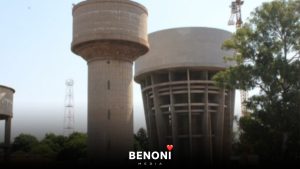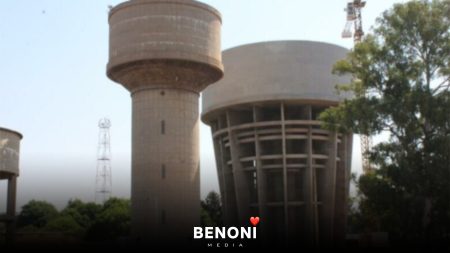Benoni, the City of Lakes: From Gold Mining to a Diverse Metropolis
The historical origins of Benoni trace back to 1881 when Johan Rissik, the Surveyor-General of the Transvaal Republic at the time, encountered challenges in assigning titles to all the unclaimed state property, known as “Uitvalgrond”, or land that had been overlooked or excluded from already claimed properties. Consequently, Rissik designated a piece of land in the area as Government Farm Benoni.
The name Benoni, which translates to “son of my sorrow”, is derived from the Hebrew language. In the biblical Book of Genesis, Rachel named her son Benoni after experiencing a particularly difficult childbirth. Tragically, Rachel didn’t survive the birth of Benoni. However, his father, Jacob, later renamed him Benjamin, which signifies ‘Son-who-will-be-fortunate’ or, in some interpretations, “Son-of-my-right-hand”.
Rissik’s choice of the name Benoni appears to be an expression of the hardship he experienced in delineating the exact boundaries of the neighboring and pre-existing farms of Rietfontein, Modderfontein, Kleinfontein, and Vlakfontein. In his view, the ordeal of formal demarcation was as intensely sorrowful as the birth of Rachel’s son. Thus, he named the unclaimed land Benoni, encapsulating the struggles he faced.

Discovery Of Gold
The birth of Benoni City primarily owes itself to the gold discovery in 1887. The subsequent establishment of mines spanned the Blesbokspruit Valley, extending from the Kleinfontein Dam in the east towards the Van Ryn and Modderfontein Deep Level mines, and extending several kilometers south of the Kleinfontein Dam, primarily west of Snake Road. During this period, the burgeoning mining industry, along with supporting businesses and infrastructure, attracted a diverse populace from Europe, America, Australia, as well as local Boer, Black, Coloured, and Indian populations, resulting in a melting pot of races, creeds, and religions that defines modern-day Benoni.
By early 1887, prospectors had traced the gold reef found in Johannesburg the previous year to outcrops located on Kleinfontein, Vlakfontein, and Modderfontein farms in the Benoni area, including the very “uitvalgrond” named Benoni by Mr. Rissik. In the interim, this land was leased to a Mr. E. W. Noyce by the Republican Government in 1885. However, the lease contained a clause stating that in the event of a gold discovery on the property, Mr. Noyce’s lease would be revoked. Ironically, gold was discovered in the north-eastern corner of the property in early 1887, which led to the proclamation of the Benoni farm as gold-bearing land on May 9, 1888. Despite this, the determined Mr. Noyce became one of the Directors of the Benoni Gold-Mining Company, which subsequently staked claims on the farm and was incorporated in September 1887. This was the first officially registered gold mine in the Benoni area.
In September 1887, gold was discovered on the Modderfontein Farm, leading to the establishment of the Chimes Mine by a group of Cornish men. For a time, the mining village was affectionately dubbed “Little Cornwall”. The successful discoveries in the subsequently established Van Ryn and Modderfontein series mines became well-known.
The Chimes Tavern was erected in 1889 to serve as a watering hole for the miners. Its name originated from the “Bell Syndicate”, a group that began prospecting for gold on the Reef in 1885, eventually striking gold near the current location of the Chimes Tavern.

Sir George Farrar
 In the annals of Benoni’s history, 1895 saw the sale of the Kleinfontein farm to the G & F Syndicate, the primary stakeholder of which was George Farrar, who later received a knighthood. Farrar had employed his water-boring apparatus effectively in the search for gold, thereby discovering a gold-bearing reef in the southeastern corner of the farm, near the spot where the first gold had been found on the Benoni farm, south of New Modder Road. The impressive size of the Kleinfontein Mine dump stands as a testament to the achievements of the New Kleinfontein mine’s subsequent ventures.
In the annals of Benoni’s history, 1895 saw the sale of the Kleinfontein farm to the G & F Syndicate, the primary stakeholder of which was George Farrar, who later received a knighthood. Farrar had employed his water-boring apparatus effectively in the search for gold, thereby discovering a gold-bearing reef in the southeastern corner of the farm, near the spot where the first gold had been found on the Benoni farm, south of New Modder Road. The impressive size of the Kleinfontein Mine dump stands as a testament to the achievements of the New Kleinfontein mine’s subsequent ventures.
Farrar embarked on a plan to design and establish the town of Benoni on the non-gold-bearing part of Kleinfontein land, nestled between the Blesbok spruit and the northern boundaries of the Benoni farm. The narrative of Benoni’s history continues as follows:
Second Boer War | History Of Benoni
In the chronicles of Benoni’s history, before the outbreak of the Second Anglo Boer War, there appear to have been intentions by the Kruger Government to establish a township named Kleinfontein on the northern slopes of Blesbokspruit, situated on Kleinfontein farmland roughly where the older part of Northmead stands today. However, this plan was never brought to fruition, as the location was considered too remote from the road leading to Boksburg and Johannesburg in the west. It was also deemed too far from the Rand Tram, which since 1890 had been operating from Boksburg to Springs to service the newly discovered coalfields in Springs and Brakpan. In those days, Brakpan was not yet a town, existing only as the Brakpan Colliery. Then, the advent of the 2nd Anglo Boer War in 1899 concluded the Transvaal Government and any subsequent plans for the township.
As spring 1902 dawned, marking the end of the Second Anglo Boer War, Sir George was inspecting the Homestead and Kleinfontein dams. These were structures he had commissioned before the war to supply water to the parched E.R.P.M. mine in Boksburg and the New Kleinfontein mine, where he had substantial financial stakes in both. The war had suspended gold-mining operations and Sir George, who had accepted a commission in the Imperial Forces during this period, had been temporarily incapable of managing these valuable assets. During the conflict, some of the Benoni mines’ stamp-batteries and headgear were destroyed, yet he was struck by how the dams had transformed from unappealing earthworks with barren shorelines into verdant, vibrant oases filled with rushes, young willows, and clear sparkling waters. The scenery was said to have reminded him of the charming River Ouse in his hometown of Bedford in the UK.
Therefore, in September, he convened with the Kleinfontein Estates and Township Company, where he held considerable sway and which was then also administering the Benoni farm, and suggested the town be established on the north-facing slopes of the Blesbok spruit valley, on Kleinfontein land adjacent to the now picturesque Kleinfontein dam, and west of the existing mining shanty-town and current-day Snake Road. The board was persuaded by Sir George Farrar’s visionary ideas and duly appointed him as the town planner of the new Benoni Township.
History Of Benoni Town
So it was that he named many of the streets, which run North-South, and Avenues, which run East-West, in honour of places and peoples of his fondest memories back in and around his hometown, Bedford in England:
Bedford Street naturally, came from the name of his home town. (It was renamed Tom Jones Street in 1919 after the then leader of the Labour Party in the Benoni Town Council). Howard Avenue was named after his grandfather who lived at Kempston Grange (spelt Kemston Avenue in Benoni) and who had taken the young Farrar on horse rides around the historical Bunyan countryside. They rode to Ampthill, a hill with fine views and then on to Elstow (curiously spelt Elston here) and then dismounted at the Swan Hotel for lunch. Russel Street almost certainly came from the family name of the Dukes of Bedford who happily resided at Woburn Abbey. Cranbourne Avenue was named after Lord Cranbourne, the Colonial Secretary of this country at the time and a good friend of Sir George’s. Wooton (spelt Wootton in England), Turvey, Rothsay and Wilstead are all place names from around Bedford. The area between Taylor and Horsefall Streets (origins unknown) he declared a public open market but Market Avenue was renamed Prince’s Avenue after the visit of H.R.H. Edward, Prince of Wales in 1925. The original market square is now occupied by the Benoni Plaza complex. The original Fort Street named after a British fort nearby was renamed Voortrekker Street in 1938 in honour of the Centenary of the Great Trek. Harpur Avenue is named in memory of the founder (Sir William Harper) of his old school, The Bedford Modern which is still in existence today and indeed makes mention of Sir George on its war memorial.

The Benoni coat of arms designed in 1937 further continued the connection with Bedford by incorporating, in the centre shield, the triple-castle coat-of-arms of the town of Bedford and in the border, three escallops taken from the coats-of-arms of the Dukes of Bedford.
It should be mentioned that Farrar had in fact wanted to name the new township Bedford but there already existed a Bedford in the Eastern Cape (ironically named in honour of the Duke of Bedford of his hometown) so he went along with the biblical name of Benoni that had been bequeathed to the Benoni farm, as cited earlier. Some variations as to the reasons for the name Benoni are detailed in the excellent book “Benoni – Son of My Sorrows”, p27-28, available in the Benoni Library.
“Foxy” Farrar, as he was often called due to his clever business nous, (he was renowned as being one of the hugely wealthy “Randlords” of the time) was an inspirational character and apart from being responsible for the laying out of our city, he also ensured that the religious, schooling, sporting and social aspects of Benoni life were catered for as well as his becoming embroiled in local politics later on.
Sir George Herbert Farrar Baronet, D.S.O. M.L.A was killed in (then) South West Africa during the 1st World War in 1915 in a train accident whilst on active army duty under the command of General Sir Duncan McKenzie who led the initial attack upon the German forces there. He presently rests-in-peace off a small road behind his magnificent Herbert Baker-designed manor house, Bedford Court, (now St. Andrews Girls’ School) in local Bedfordview.

Thousands of trees were planted in the new mining district and it was officially declared the Township of Benoni in 1906.
Residents of that time were predominantly British or those from the Jewish population who had suffered anti-Semitism in eastern Europe, lost all their possessions and who had came to start life afresh here.

In 1907, the first synagogue and the Benoni Race Track were opened. This horse-racing track was breathtaking by its sheer size as compared to the small mining town in which it was situated. The first race was run on Saturday 7 December 1907 and was won by a pony named Fusy owned by John (Jack) William Travis, a Jewish farrier on the gold mines who had come from England. Two unusual prizes were awarded for that first race, a mounted golden whip for the jockey and a gold medal for the owner of the pony. John William Travis imported the first race horses from England for Benoni racing.
Rand Revolt
History Of Benoni – In 1922, the Rand Revolt (or 1922 Strike) broke out throughout the mines on the Witwatersrand and thousands of white miners went on strike. The strike was partly led by the South African Communist Party and was not well received by the South African Government so soon after the Russian Communist Revolution of 1917.
The strike quickly degenerated into open revolt, with armed miners fighting the South African police and army in the streets. The revolt lasted for about a year and the miners were bombed by the newly formed South African Air Force (SAAF) during this time. Some of the SAAF aeroplanes were shot down by ground fire from the miners. During the revolt, Benoni was used as one of the headquarters of the miners and much fighting took place in and around the area. The Benoni Museum details this episode in the town’s history.
More information on the Rand Rebellion here
Benoni Airfield
During World War II, the South African Airforce trained pilots in Benoni on the aerodrome which now constitutes the suburb of Airfield.
Introducing Rugby To Benoni
In 1957, in an effort to introduce the sport of rugby league to South Africa, Great Britain and France played the first of a series of three exhibition matches in Benoni.
Royal Visits To Benoni | History Of Benoni
Benoni has been honoured with three British royal visits, as well as several visits from Princess Charlene Wittstock of Monaco who grew up in Benoni.
Today Benoni remains an English-speaking city with rich Jewish history.
Benoni today
Benoni is a diverse city. It boasts more horse stables per square kilometer than anywhere in the southern hemisphere. Benoni has over ten schools; in some areas there is a concentration of up to 6000 students within a 5 km radius. Ashton International College was founded here in 1998.
Over time gold mining has decreased in importance. Today the city is focused more on industry and services, rather than mining, and is used as a service hub for other East Rand towns such as Brakpan, Nigel and Springs. Benoni is also the site of the Benoni Heliport, for the use of helicopters.

City Of Lakes
Due to the string of four lakes; Homestead, Middle, Civic and Kleinfontein, the Rynfield dam and numerous pans, most notably Korsman’s, Bullfrog and Sandpan, the city of Benoni is affectionately known by its residents as the City of Lakes.
View Gallery: Photos of Benoni







